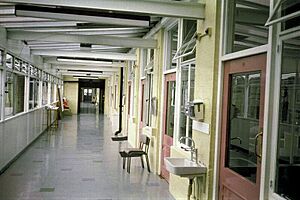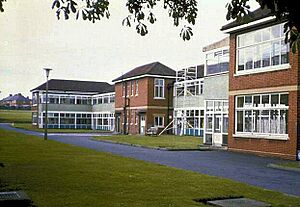1978 smallpox outbreak in the United Kingdom facts for kids
The 1978 smallpox outbreak in the United Kingdom was a serious event. It led to the death of Janet Parker, a medical photographer. She became the last person ever recorded to die from smallpox. Her illness and death, along with two other related cases, caused a big official investigation called the Shooter Inquiry. This inquiry led to major changes in how dangerous germs are studied in the UK.
The Shooter Inquiry found that Janet Parker was accidentally exposed to a type of smallpox virus. This virus was being grown in a research lab right below her workplace at the University of Birmingham Medical School. The inquiry thought the virus most likely spread through the air, traveling up a poorly maintained pipe system between the floors. However, this idea has been questioned since. For example, the University of Birmingham was later found not guilty when charged with breaking safety laws related to Parker's death. Many international experts showed that it was unlikely Parker got infected by airborne spread in that way. While everyone agrees the smallpox virus came from the Medical School lab, exactly how Parker caught the disease is still a mystery.
Contents
What is Smallpox?
Smallpox is a very serious infectious disease that only affects humans. It's caused by two types of viruses: Variola major and Variola minor. Variola minor usually causes a milder sickness. The World Health Organization (WHO) had a program to get rid of smallpox completely. By 1978, they were very close to announcing that the disease was gone worldwide. The last natural infection of Variola minor happened in Somalia in 1977.
Smallpox Research at Birmingham University
At the time of the 1978 outbreak, a lab at the University of Birmingham Medical School was studying smallpox viruses. These were called "whitepox viruses." Scientists thought these viruses could threaten the WHO's plan to wipe out smallpox. This lab was part of the Microbiology Department, led by a virologist named Henry Bedson.
In 1977, the WHO had turned down Henry Bedson's request for his lab to become a special Smallpox Collaborating Centre. This was partly because of safety worries. The WHO wanted as few labs as possible to handle the dangerous virus.
Who Was Janet Parker?
Janet Parker was born in March 1938. She was married to Joseph Parker. She worked as a medical photographer in the Anatomy Department at the University of Birmingham Medical School. She often worked in a darkroom. This darkroom was located right above the lab where the smallpox virus research was happening.
How the Infection Happened
Janet Parker's Sickness and Death
On August 11, 1978, Janet Parker became sick. She had a headache and muscle pains. She then developed spots, which doctors first thought were a mild rash or chickenpox. On August 20, she was admitted to East Birmingham Hospital. There, doctors realized she had Variola major, the most serious type of smallpox.
Janet Parker died from smallpox on September 11, 1978. She was the last person ever recorded to die from this disease.
Stopping the Spread
Many people had been close to Janet Parker before she went to the hospital. To stop the disease from spreading, 260 people were immediately put into quarantine. Over 500 people who might have been in contact with Parker were given smallpox vaccinations. On August 26, health officials went to Parker's house and cleaned her home and car with special chemicals. On August 28, five hundred people were placed in quarantine in their homes for two weeks.
Parker's mother also got smallpox on September 7, even though she had been vaccinated. Her case was very mild. She was later declared free from infection and left the hospital on September 22. Besides Parker's mother, no other cases of smallpox happened.
Birmingham was officially declared free of smallpox on October 16, 1978. More than a year later, in October 1979, the university also cleaned the Medical School building. The hospital ward where Parker died remained sealed off for five years after her death, with everything inside untouched.
The Investigations
The Shooter Inquiry
An official government investigation into Janet Parker's death was led by microbiologist R.A. Shooter. The inquiry's report noted that Henry Bedson had not told authorities about changes in his research that could have affected safety. The inquiry found that the lab's safety measures were not good enough, even though experts had checked it before. Some staff in the lab had not received special training.
The report concluded that Parker was infected by a type of smallpox virus called Abid. This virus was being handled in the smallpox lab in July 1978. The report was sure that Parker was infected at her workplace. It suggested three ways this could have happened: through air currents, by personal contact, or by touching contaminated equipment. The report mostly believed the air current idea. It suggested the virus could have traveled up a service duct from the lab below to a room where Parker made phone calls.
The Court Case
On December 1, 1978, the Health and Safety Executive announced they would take the university to court for breaking safety laws. The case was heard in October 1979.
Even though the source of the infection was found, how the virus actually spread was not clear. Experts showed that it was very unlikely the virus traveled through the air from the lab to the telephone room where Parker was supposedly infected. They calculated that it would take a huge amount of virus fluid and thousands of years for one tiny particle to reach that room by air. It was also found that the poor condition of the ducts in the lab happened *after* the outbreak, when engineers were cleaning the lab. The university was found not guilty of causing Parker's death.
What We Learned
It seems clear that the smallpox virus that infected Janet Parker came from the University of Birmingham Medical School lab. However, exactly how she got infected is still unknown. The criticisms from the Shooter Inquiry about the lab's safety rules led to big changes in how dangerous germs are studied in the UK. But the inquiry's ideas about how the virus spread are not widely accepted.
After this incident, all known samples of smallpox virus were either destroyed or moved to one of two special WHO labs. These labs have the highest level of safety, called BSL-4. They are located in the United States and Russia.
At the time of the outbreak, the WHO was about to announce that smallpox had been completely wiped out worldwide. They finally did so in 1980.
See also
- Rahima Banu, the last person infected with naturally occurring Variola major
- Ali Maow Maalin, the last person infected with naturally occurring Variola minor
- Surinder Singh Bakhshi







